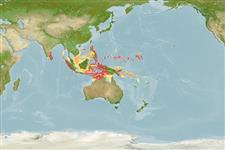>
Eupercaria/misc (Various families in series Eupercaria) >
Malacanthidae (Tilefishes)
Etymology: Hoplolatilus: Greek, hoplon = weapon + Latin, latus = wide (Ref. 45335); randalli: Named for John E. Randall, in recognition of his numerous valuable contributions to our knowledge of Indo-Pacific fishes and particularly his previous work on the genus Hoplolatilus..
Environment: milieu / climate zone / depth range / distribution range
Ecologie
marien rifbewoner; diepte 30 - 85 m (Ref. 85568). Tropical
Indo West Pacific: Indonesia, Philipines, Palau, Yap Is. and the Solomon Islands.
Grootte / Gewicht / Leeftijd
Maturity: Lm ? range ? - ? cm
Max length : 15.4 cm SL mannelijk / geslacht onbekend; (Ref. 85568)
Korte beschrijving
Morfologie | Morfometrie
Dorsale stekels (totaal): 10; Dorsale zachte stralen (totaal): 13; Anale stekels 2; Anale zachte stralen: 12; Wervels: 24. This species is distinguished by the following characters: D X,13; A II,12; pectoral rays 17; total gill rakers on first branchial arch 27-29; pored lateral line scales 84-92 with 98-120 scales in lateral series above lateral line; preopercular serrae 16-23; greatest body depth 3.4-3.9 in SL; length of last dorsal spine 2.5-3.0 in HL; longest soft dorsal ray 1.1-1.4 in HL; colour in life mainly greenish (darker dorsally), shading to light blue on lower head, thorax, and abdomen; caudal peduncle with an elongate sky aqua-blue saddle-like spot dorsally; narrow sky-blue band from front of snout to lower edge of eye; lips mainly blue; narrow yellow-orange band just below blue band, passing just under eye to posterior margin of preoperculum; dorsal and anal fins pale yellow with pink margin; caudal fin reddish with indistinct central pale streak, the upper and lower margins narrowly light blue to pinkish; pectoral fins mainly translucent except upper 4-5 rays blue; pelvic fins bluish white; iris yellow with bright blue streak dorsally and ventrally (Ref. 85568).
Inhabits gentle rubble slopes; constructs impressive rubble mounds over its burrows, which range from about 50-70 cm in height and 1.5-2 m in diameter and typically, the fish are seen hovering a short distance from their home mound, with up to six individuals using a single mound. The fish when approached closely or frightened by spear shots, quickly retreat
into the burrow, which is located near the apex of the mound (Ref. 85568).
Levenscyclus en paargedrag
Maturiteit | Voortplanting | Paaien | Eieren | Fecunditeit | Larven
Allen, G.R., M.V. Erdmann and A.M. Hamilton, 2010. Hoplolatilus randalli, a new species of sand tilefish (Pisces: Malacanthidae) from the tropical western Pacific with comments on the validity of H. luteus. aqua, Int. J. Ichthyol. 16(4):171-186. (Ref. 85568)
Status op de Rode Lijst van het IUCN (Ref. 130435)
Gevaar voor de mens
Harmless
Gebruik door de mens
Meer informatie
Lokale namenSynoniemenMetabolismePredatorenEcotoxicologieVoortplantingMaturiteitPaaienPaaiaggregatiesFecunditeitEierenOntwikkeling van de eieren
Leeftijd/GrootteGroeiLengte-gewichtLengte-lengteLengtefrequentiesMorfometrieMorfologieLarvenLarvale populatiedynamiekRekruteringAbundantieBRUVS
ReferentiesAquacultuurAquacultuurprofielKweeklijnenGeneticaElectrophoresesErfelijkheidZiektesVerwerkingNutrientsMassaconversie
Tools
Speciale rapporten
Download XML
Internetbronnen
Estimates based on models
Preferred temperature (Ref.
123201): 26.7 - 28.6, mean 27.6 °C (based on 41 cells).
Fylogenetische diversiteitsindex (Ref.
82804): PD
50 = 0.5001 [Uniqueness, from 0.5 = low to 2.0 = high].
Bayesian length-weight: a=0.01122 (0.00514 - 0.02450), b=3.04 (2.87 - 3.21), in cm total length, based on all LWR estimates for this body shape (Ref.
93245).
Trofisch niveau (Ref.
69278): 3.5 ±0.5 se; based on size and trophs of closest relatives
Fishing Vulnerability (Ref.
59153): Low vulnerability (10 of 100).
